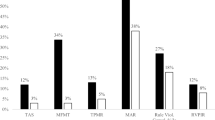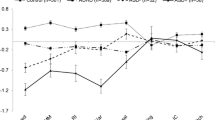Abstract
Although response inhibition has been proposed as a core element of child attention-deficit hyperactivity disorder (ADHD), the literature is heavily reliant on studies using DSM–III–R diagnostic criteria, older methods of measuring response inhibition, samples of boys, and failing to control thoroughly for comorbid problems—both as diagnoses and as subclinical variation. The present study replicated a deficit in response inhibition in the ADHD combined type (DSM–IV, American Psychiatric Association, 1994) using samples matched on age and sex. The study replicated an effect size of approximately d = .6 in boys with ADHD, and observed an even larger effect size for girls, although the Sex × Group interaction was nonsignificant. Children with ADHD also had problems with response output, shown by variable responding. Excluding comorbid conduct disorder, reading disorder, generalized anxiety disorder, obsessive–compulsive disorder, major depression, and posttraumatic stress disorder from the sample did not alter the results. Correlations indicated that response inhibition was associated with both attentional problems and reading level. Covarying for reading problems did not eliminate the ADHD group effect, but the association of response inhibition with reading clearly requires further examination. Overall, the study supported the role of response inhibition in the DSM–IV ADHD combined type, but with key qualifications as to degree of specificity in reference both to comorbid problems and other executive functions.
Similar content being viewed by others
REFERENCES
Achenbach, T. M. (1991). Manual for the Child Behavior Checklist/4–18 and 1991 Profile. Burlington: University of Vermont, Department of Psychiatry.
Aman, C. J., Roberts, R. J., & Pennington, B. F. (1998). A neuropsychological examination of the underlying deficit in ADHD: The frontal lobe versus right parietal lobe theories. Developmental Psychology, 34, 956–969.
American Psychiatric Association. (1994). Diagnostic and statistical manual of mental disorders (4th ed.). Washington, DC: Author.
Arnold, L. E. (1996). Sex differences in ADHD: Conference summary. Journal of Abnormal Child Psychology, 24, 555–569.
Barkley, R. A. (1997). Behavioral inhibition, sustained attention, and executive function: Constructing a unified theory of ADHD. Psychological Bulletin, 121, 65–94.
Biederman, J., Newcorn, J., & Sprich, S. (1991). Comorbidity of attention deficit hyperactivity disorder with conduct, depressive, anxiety, and other disorders. American Journal of Psychiatry, 148. 564–577.
Casey, B. J., Castellanos, F. X., Giedd, J. N., Marsh, W. L., Hamburger, S. D., Schubert, A. B., Vauss, Y. C., Vaituzis, C. K., DicKstein, D. P., Sarfatti, S. E., & Rapoport, J. L. (1997). Implication of right frontostriatal circuitry in response inhibition and attentiondeficit/ hyperactivity disorder. Journal of the American Academy of Child and Adolescent Psychiatry, 36, 374–383.
Chapman, L. J., & Chapman, J. P. (1978). The measurement of differential deficit. Journal of Psychiatric Research, 14, 303–311.
Chelune, G. J., Ferguson, W., Koon, R., & Dickey, T. O. (1986). Frontal lobe disinhibition in attention deficit disorder. Child Psychiatry and Human Development, 16, 221–234.
Chen, W. J., Faraone, S. V, Biederman, J., & Tsuang, M. T. (1994). Diagnostic accuracy of the Child Behavior Checklist Scales for attention-deficit hyperactivity disorder: A reciever-operating characteristics analysis. Journal of Consulting and Clinical Psychology, 62, 1017–1025.
Cohen, J. (1988). Statistical power analysis for the behavioral sciences. Hillsdale, NJ: Erlbaum.
Ernst, M., Liebenauer, L. L., King, C., Fitzgerald, G. A., Cohen, R. M., & Zametkin, A. J. (1994). Reduced brain metabolism in hyperactive girls. Journal of the American Academy of Child and Adolescent Psychiatry, 33, 858–868.
Eysenck, H. J., & Eysenck, M. W. (1985). Personality and individual differences: A natural science approach. New York: Plenum.
Farrington, D. P., Loeber, R., & van Kammen, W. B. (1990). Long term criminal outcomes of hyperactivity-impulsivity-attention deficit and conduct problems in childhood. In L. Robins & M. Rutter. (Eds.), Straight and devious pathways from childhood to adulthood (pp. 62–81). New York: Cambridge University Press.
Goodman, S. H., Lahey, B. B., Fielding, B., Dulcan, M., Narrow, W., & Regier, D. (1997). Representativeness of clinical samples of youths with mental disorders: A preliminary population-based study. Journal of Abnormal Psychology, 106, 3–14.
Hinshaw, S. P. (1987). On the distinction between attentional deficits/ hyperactivity and conduct problems/aggression in child psychopathology. Psychological Bulletin, 101, 443–463.
Hinshaw, S. P. (1992). Externalizing behavior problems and academic underachievement in childhood and adolescence: Causal relationships and underlying mechanisms. Psychological Bulletin, 111, 127–155.
Hinshaw, S. P., March, J. S., Abikoff, H., Arnold, L. E., Cantwell, D. P., Conners, C. K., Elliot, G. R., Halperin, J., Greenhill, L. L., Hechtman, L. T., Hoza, B., Jensen, P. S., Newcorn, J. H., McBurnett, K., Pelham, W. E., Richters, J. E., Severe, J. B., Schiller, E., Swanson, J., Vereen, D., Wells, K., & Wigal, T. (1997). Comprehensive assessment of childhood attention-deficit hyperactivity disorder in the context of a multisite, multimodal clinical trial. Journal of Attention Disordrs, 1, 217–234.
Iaboni, F., Douglas, V. L, & Baker, A. G. (1995). Effects of reward and response costs on inhibition in ADHD children. Journal of Abnormal Psychology, 104, 232–240.
James, A., & Taylor, E. (1990). Sex differences in the hyperkinetic syndrome of childhood. Journal of Child Psychology and Psychiatry, 31, 437–446.
Kenrick, D. T., & Funder, D. C. (1988). Profiting from controversy: Lessons from the person-situation debate. American Psychologist, 43, 23–34.
Klein, R. G., & Mannuzza, S. (1991). Long-term outcome of hyperactive children: A review. Journal of the American Academy of Child and Adolescent Psychiatry, 30, 383–387.
Kosten, T. A., & Rounsaville, B. J. (1992). Sensitivity of psychiatric diagnosis based on the best estimate procedure. American Journal of Psychiatry, 149, 1225–1227.
Logan, G. D. (1994). A users guide to the stop signal paradigm. In D. Dagenbach and T. H. Carr (Eds.), Inhibitory processes in attention, memory, and language (pp. 189–239). San Diego, CA: Academic Press.
Logan, G. D., & Cowan, W. B. (1984). On the ability to inhibit thought and action: A theory of an act of control. Psychological Review, 91, 295–327.
Logan, G. D., Schachar, R. J., & Tannock, R. (1997). Impulsivity and inhibitory control. Psychological Science, 8, 60–64.
Mezzacappa, E., Kindlon, D., Saul, J. P., & Earls, F. (1998). Executive and motivational control of performance task behavior and autonomic heartrate regulation in children: Physiologic validation of two-factor solution inhibitory control. Journal of Child Psychology and Psychiatry, 39, 525–531.
Milich R., & Kramer, J. (1984). Reflections on impulsivity: An empirical investigation of impulsivity as a construct. In K. Gadow & I. Bialer (Eds.), Advancesin learning and behavioral disabilities (Vol. 3, pp. 57–94). Greenwich, CT: JAI.
Nigg, J. T., Hinshaw, S. P., Carte, E., & Treuting, J. (1998). Neuropsychological correlates of antisocial behavior and comorbid disruptive behavior disorders in children with ADHD. Journal of Abnormal Psychology, 107, 468–480.
Oosterlaan, J., Logan, G. D., & Sergeant, J. A. (1998). Response inhibition in ADHD, CD, comorbid ADHD + CD, anxious, and normal children: A meta-analysis of studies with the stop task. Journal of Child Psychiatry and Psychology, 39, 411–426.
Oosterlaan, J., & Sergeant, J. A. (1996). Inhibition in ADHD, aggressive, and anxious children: A biologically based model of child psychopathology. Journal of Abnormal Child Psychology, 24, 19–36.
Parasuraman, R., Warm, J., & See, J. (1998). Brain systems of vigilance. In R. Parasuraman (Ed.), The attentive brain (pp. 221–256). Cambridge, MA: MIT Press.
Pennington, B. F., & Ozonoff, S. (1996). Executive functions and developmental psychopathology. Journal of Child Psychology and Psychiatry, 37, 51–87.
Pliszka, S. R., Borcherding, S. H., Spratley, K., Leon, S., & Irick, S. (1997). Measuring inhibitory control in children. Developmental and Behavioral Pediatrics, 18, 254–259.
Quay, H. C. (1988). Attention-deficit disorder and the behavioral inhibition system: The relevance of the neuropsychological theory of Jeffrey A. Gray. In L. M. Bloomingdale & J. Sergeant (Eds.), Attention-deficit disorder: Criteria, cognition, intervention (pp. 117–126). New York: Pergamon.
Quay, H. C. (1997). Inhibition and attention deficit hyperactivity disorder. Journal of Abnormal Child Psychology, 25, 7–13.
Sattler, J. M. (1992). Assessment of children: Revised and updated. (3rd ed.). San Diego, CA: Author.
Schachar, R., & Logan, G. D. (1990). Impulsivity and inhibitory control in normal development and childhood psychopathology. Developmental Psychology, 26, 710–720.
Schachar, R., Tannock, R., Marriott, M., & Logan, G. D. (1995). Deficient inhibitory control and attention deficit hyperactivity disorder. Journal of Abnormal Child Psychology, 23, 411–437.
Schwab-Stone, M. E., Shaffer, D., Dulcan, M. K., Jensen, P. S., Fisher, P., Bird, H. R., Goodman, S. H., Lahey, B. B., Lichtman, J. H., Canino, G., Rubio-Stipec, M., & Rae, D. S. (1996). Criterion validity of the NIMH Diagnostic Interview Schedule for Children Version 2.3 (DISC-2.3). Journal of the American Academy of Child and Adolescent Psychiatry, 35, 878–888.
Sergeant, J. A., Oosterlaan, J., & van der Meere, J. (1999). Information processing and energetic factors in attention deficit/hyperactivity disorder. In H. C. Quay & A. Hogan (Eds.), Handbook of disruptive behavior disorders (pp. 75–104). New York: Plenum Press.
Shaffer, D., Fisher, P., & Lucas, C. (1997). NIMH Diagnostic Interview Schedule for Children-IV. New York: Ruane Center for Early Diagnosis, Division of Child Psychiatry, Columbia University.
Swanson, J. M. (1992). School based assessments and interventions for ADD students. Irvine, CA: K.C. Publications.
Tannock, R. (1998). Attention deficit hyperactivity disorder: Advances in cognitive, neurobiological, and genetic research. Journal of Child Psychology and Psychiatry, 39, 65–99.
Tannock, R., & Marriott, M. (1992). Learning disabilities: Converging evidence of deficits in inhibitory processes. Proceedings of the 39th annual meeting of the American Academy of Child and Adolescent Psychiatry, 8, 89.
Wechsler, D. (1991). Wechsler Intelligence Scale for Children (3rd ed.).San Antonio, TX: Psychological Corporation.
Wechsler, D. (1992). Wechsler Individual Achievement Test. San Antonio, TX: Psychological Corporation.
Author information
Authors and Affiliations
Corresponding author
Rights and permissions
About this article
Cite this article
Nigg, J.T. The ADHD Response-Inhibition Deficit as Measured by the Stop Task: Replication with DSM–IV Combined Type, Extension, and Qualification. J Abnorm Child Psychol 27, 393–402 (1999). https://doi.org/10.1023/A:1021980002473
Issue Date:
DOI: https://doi.org/10.1023/A:1021980002473




